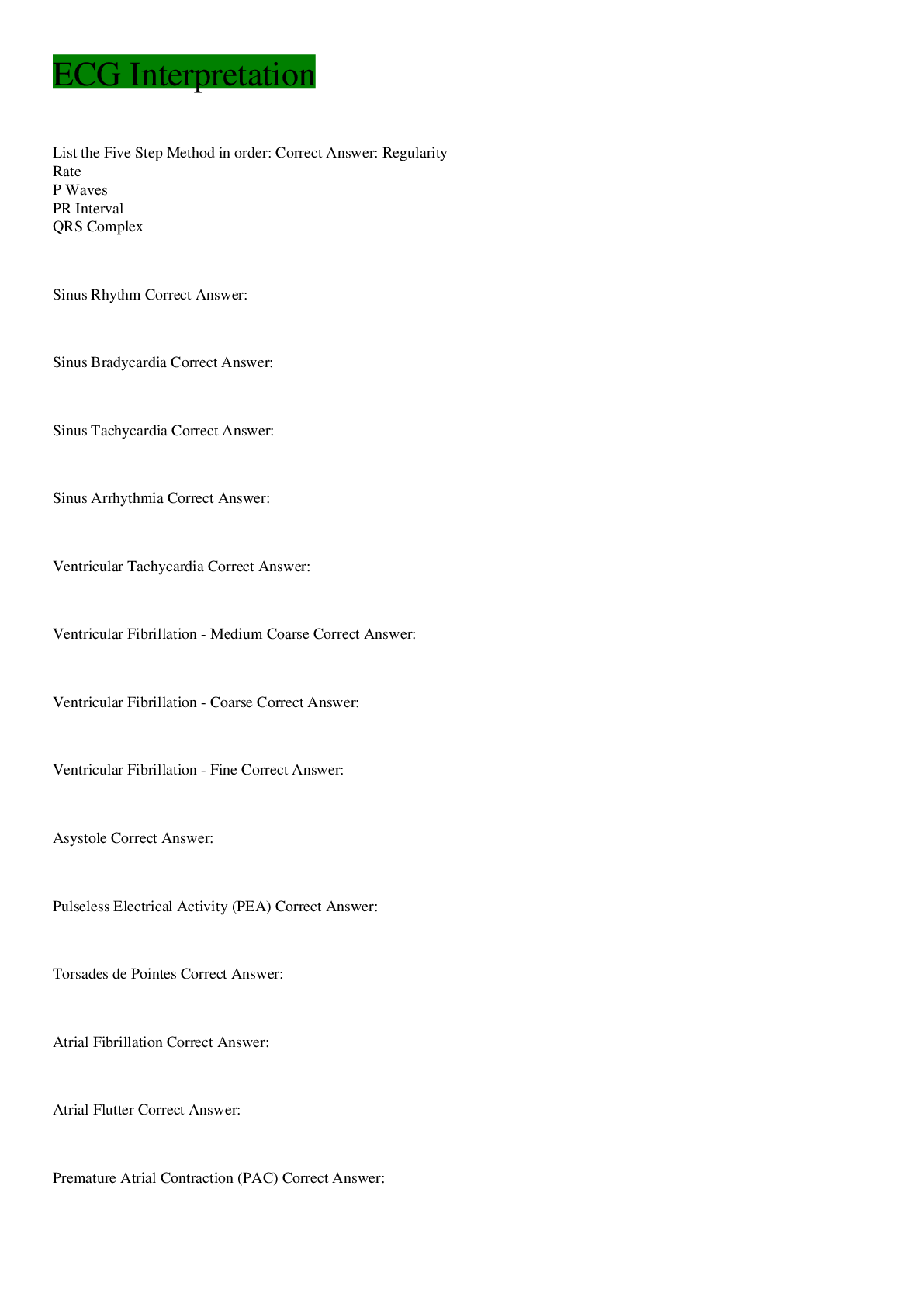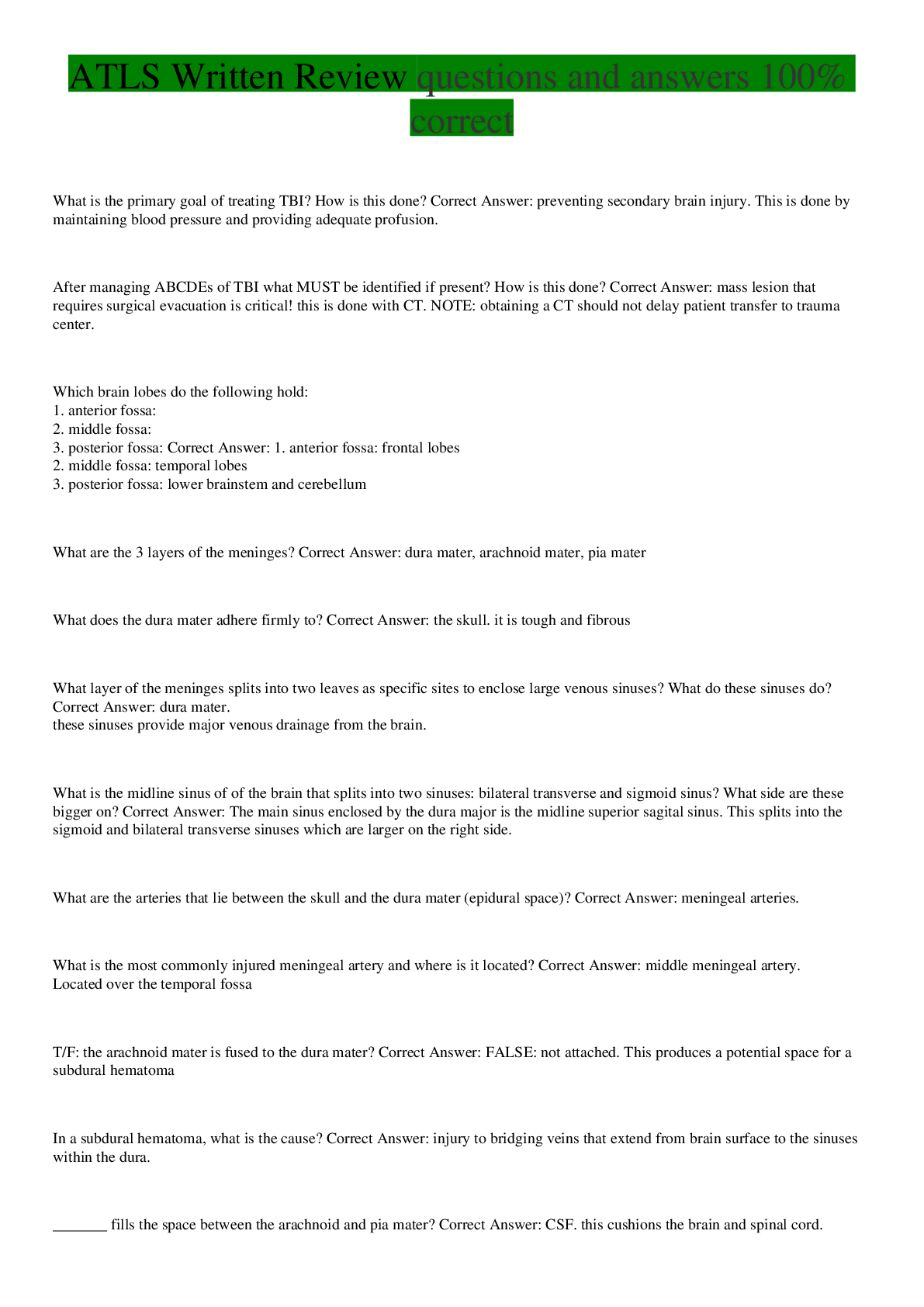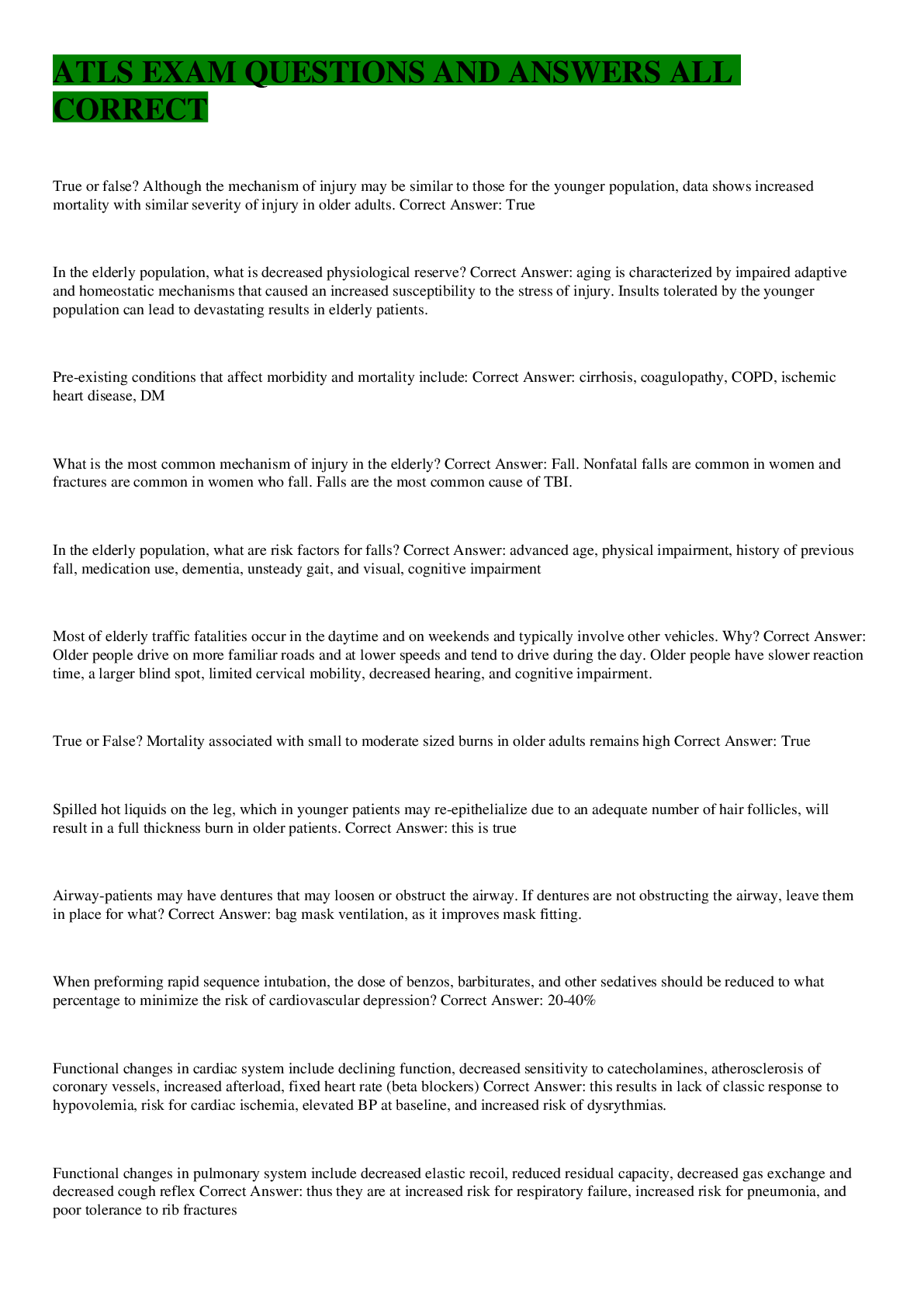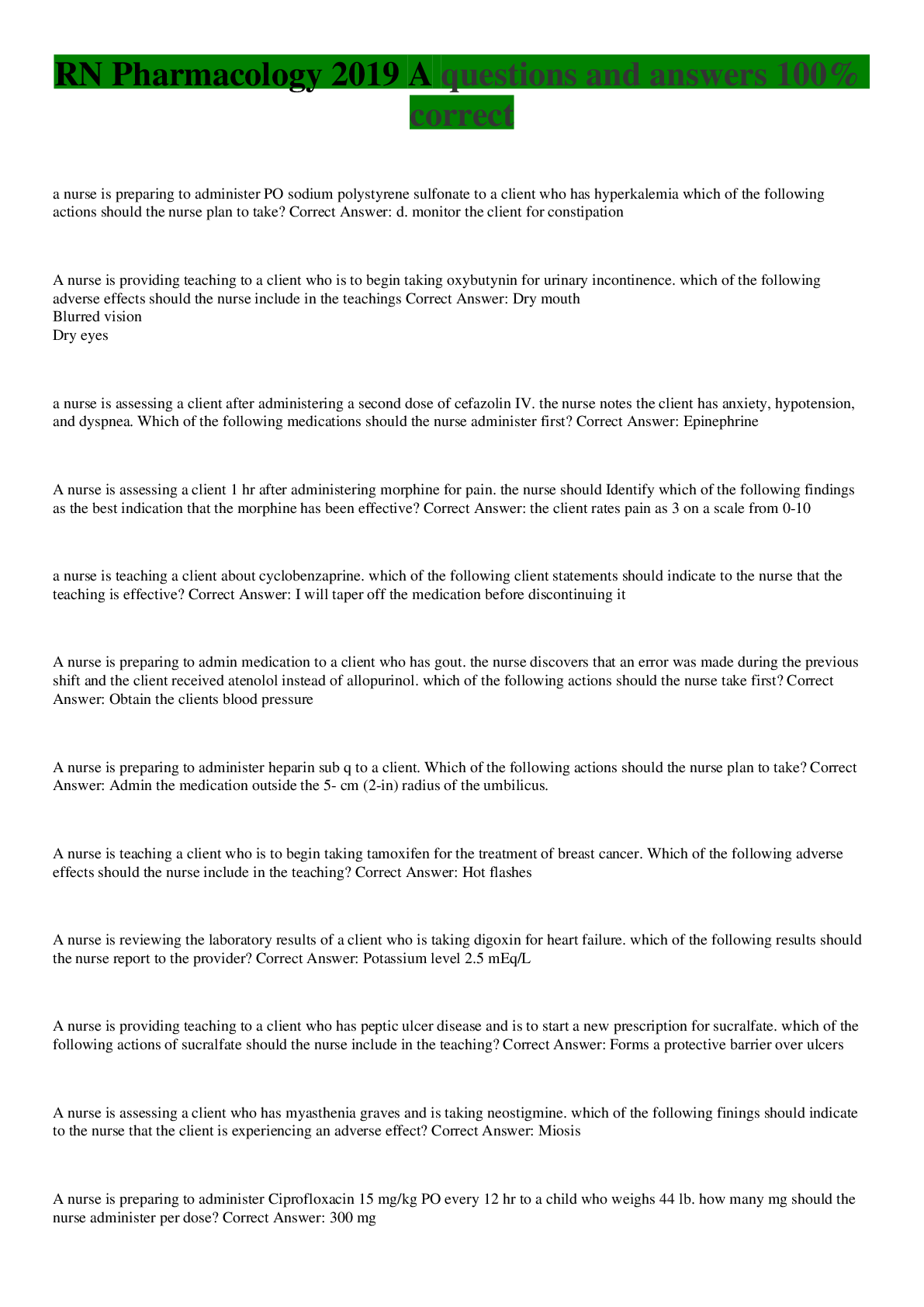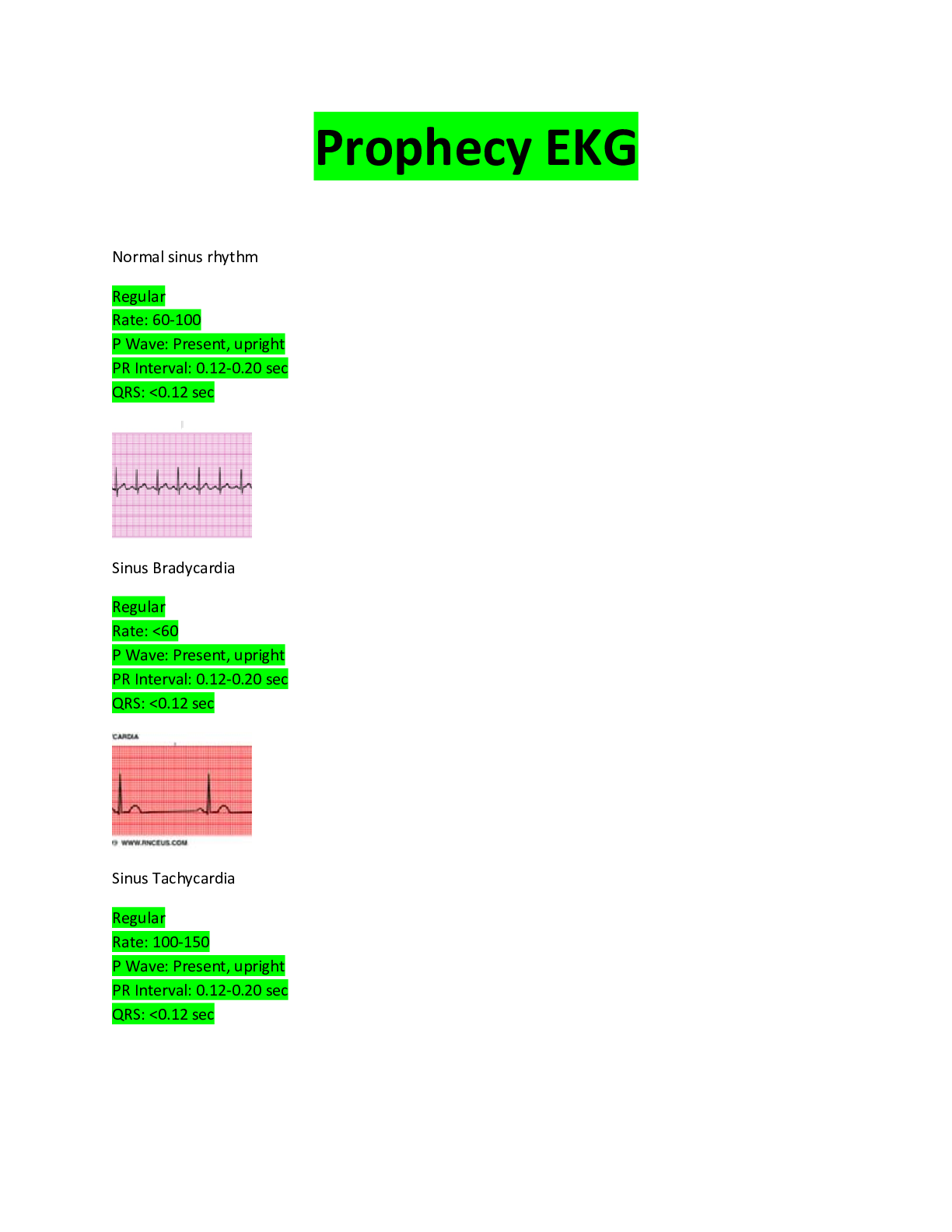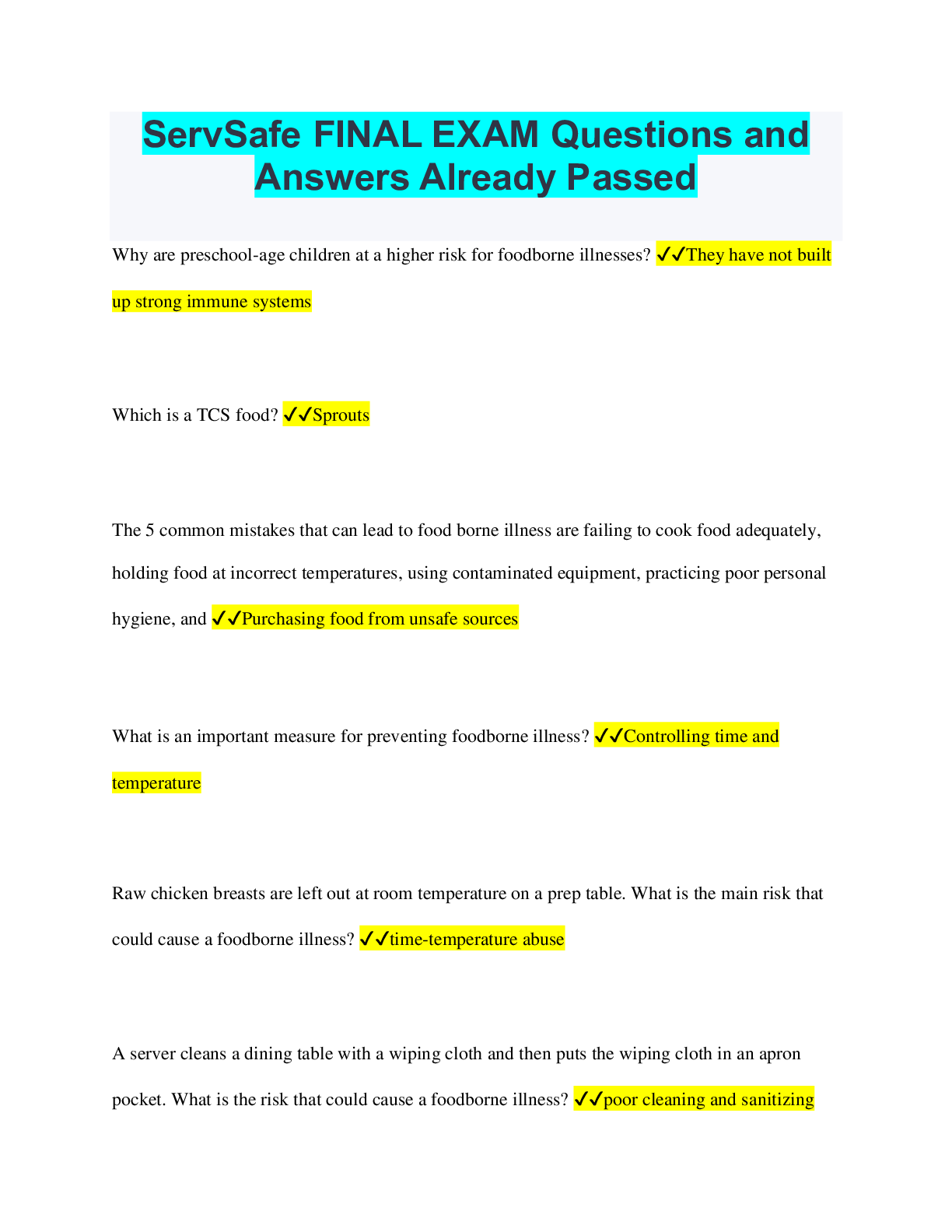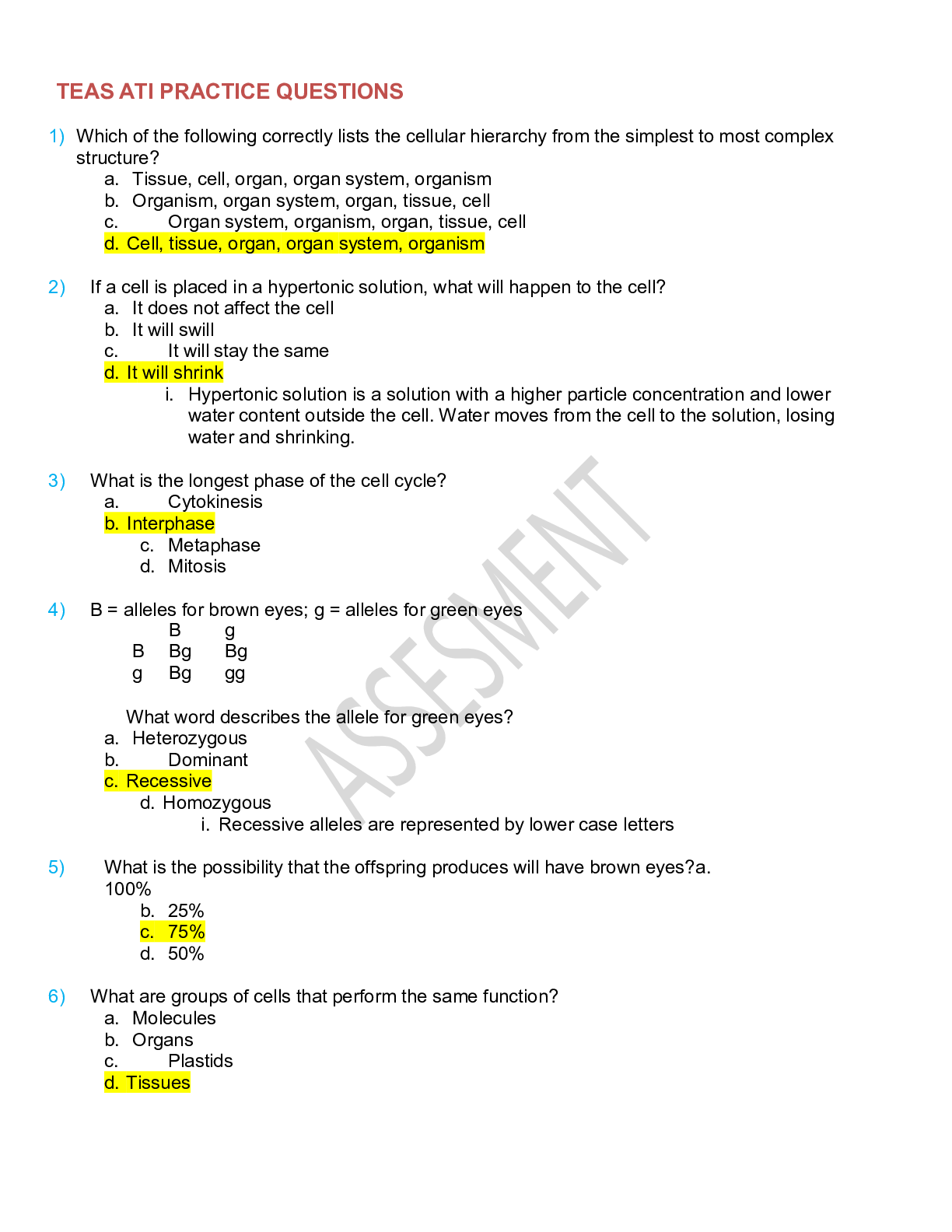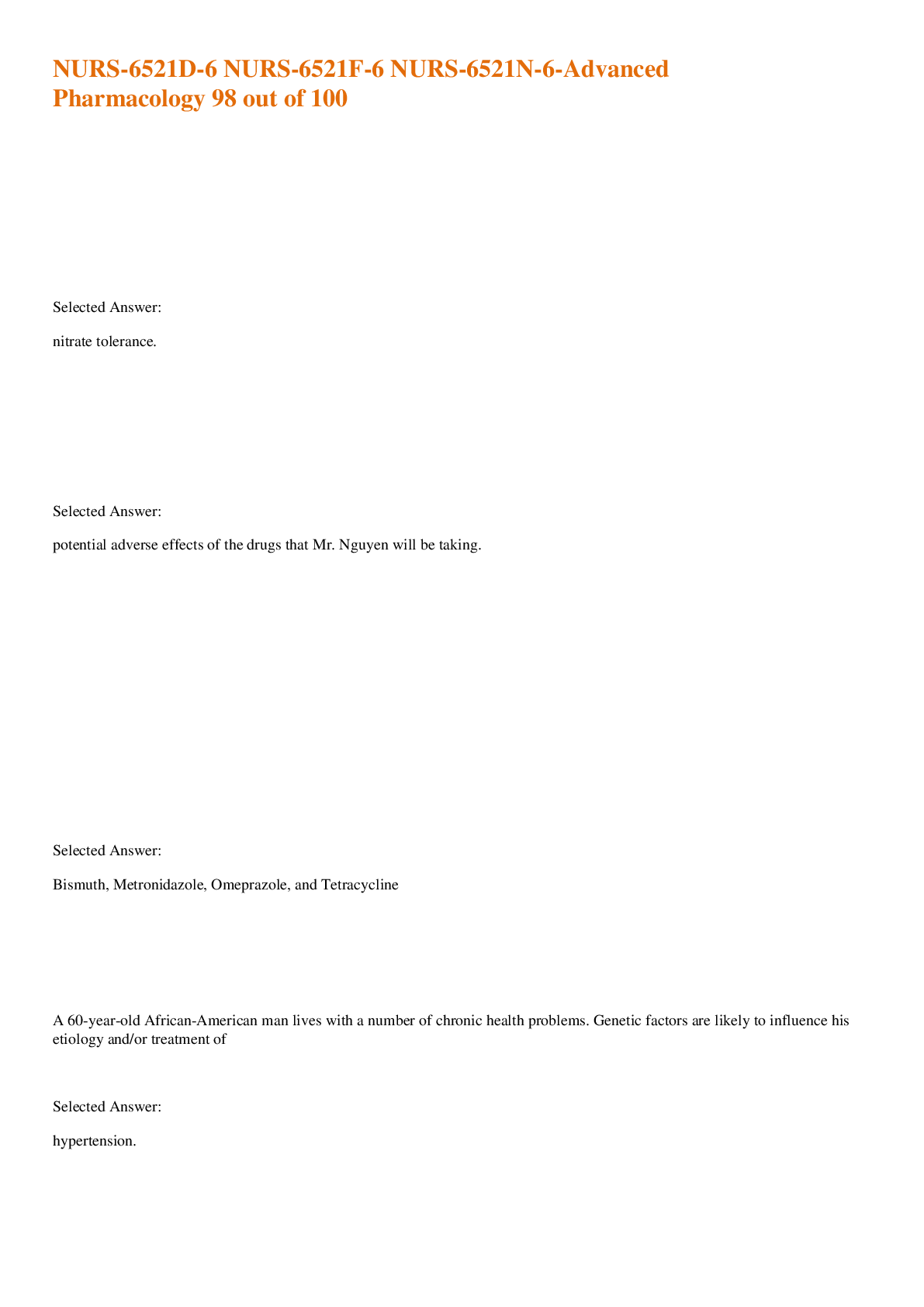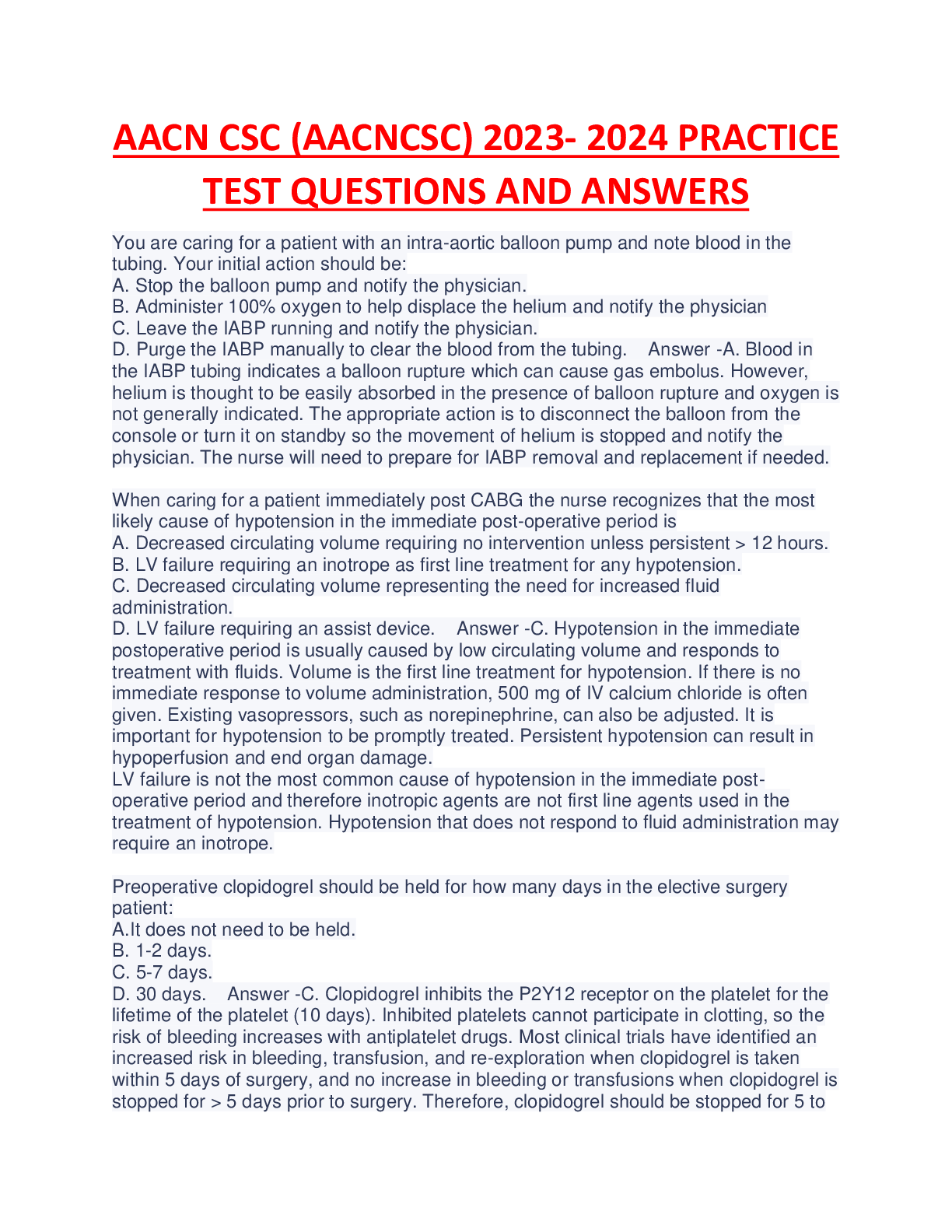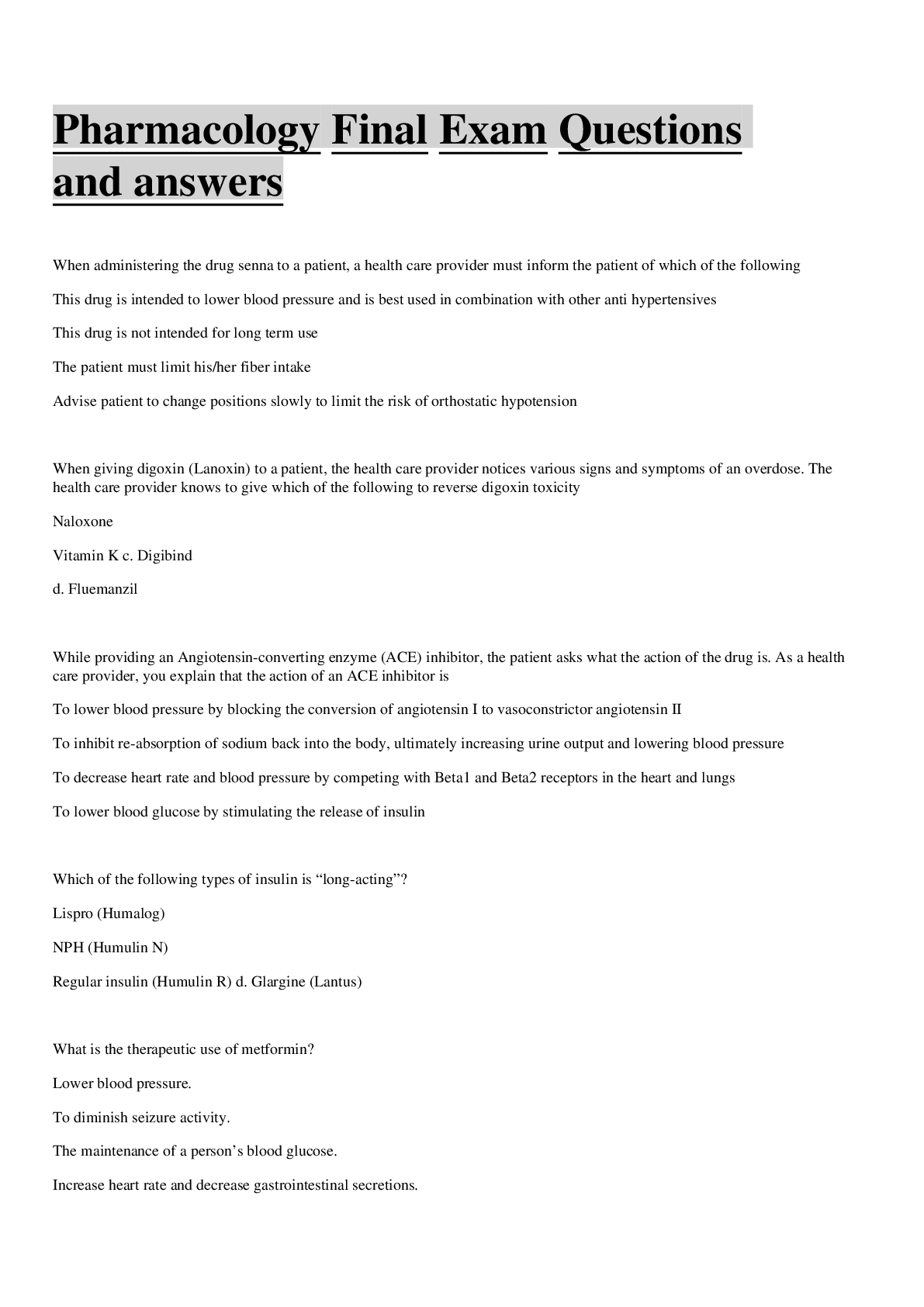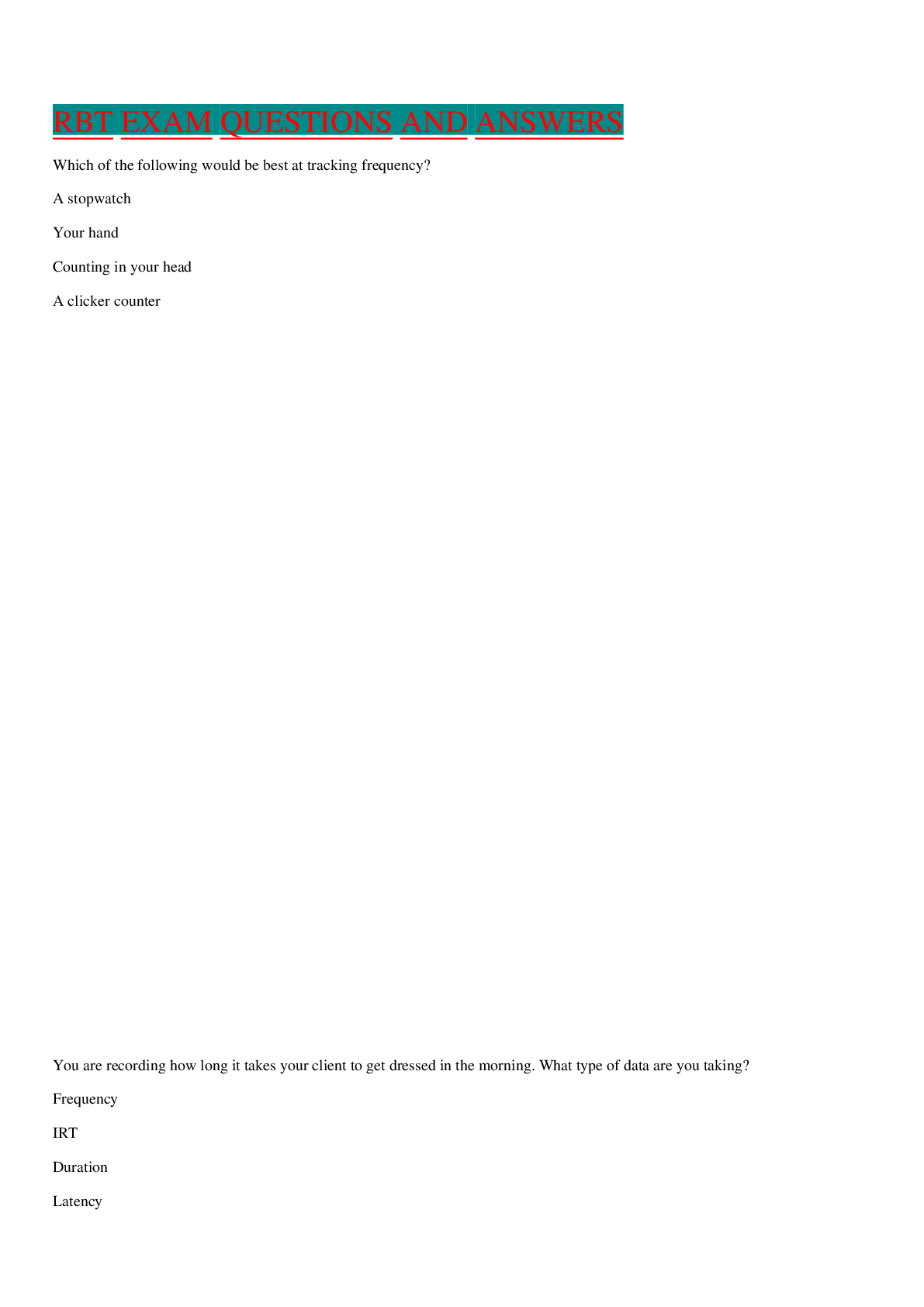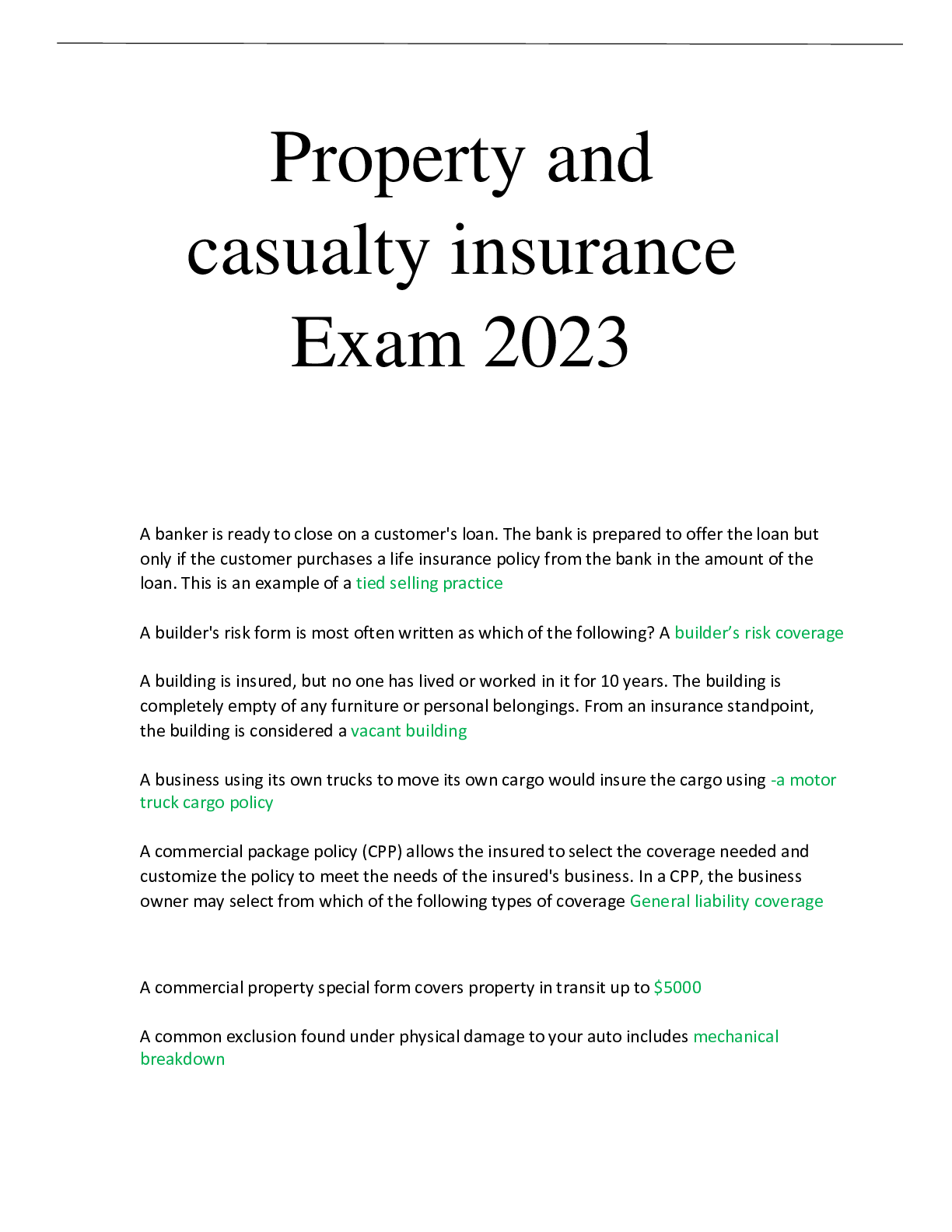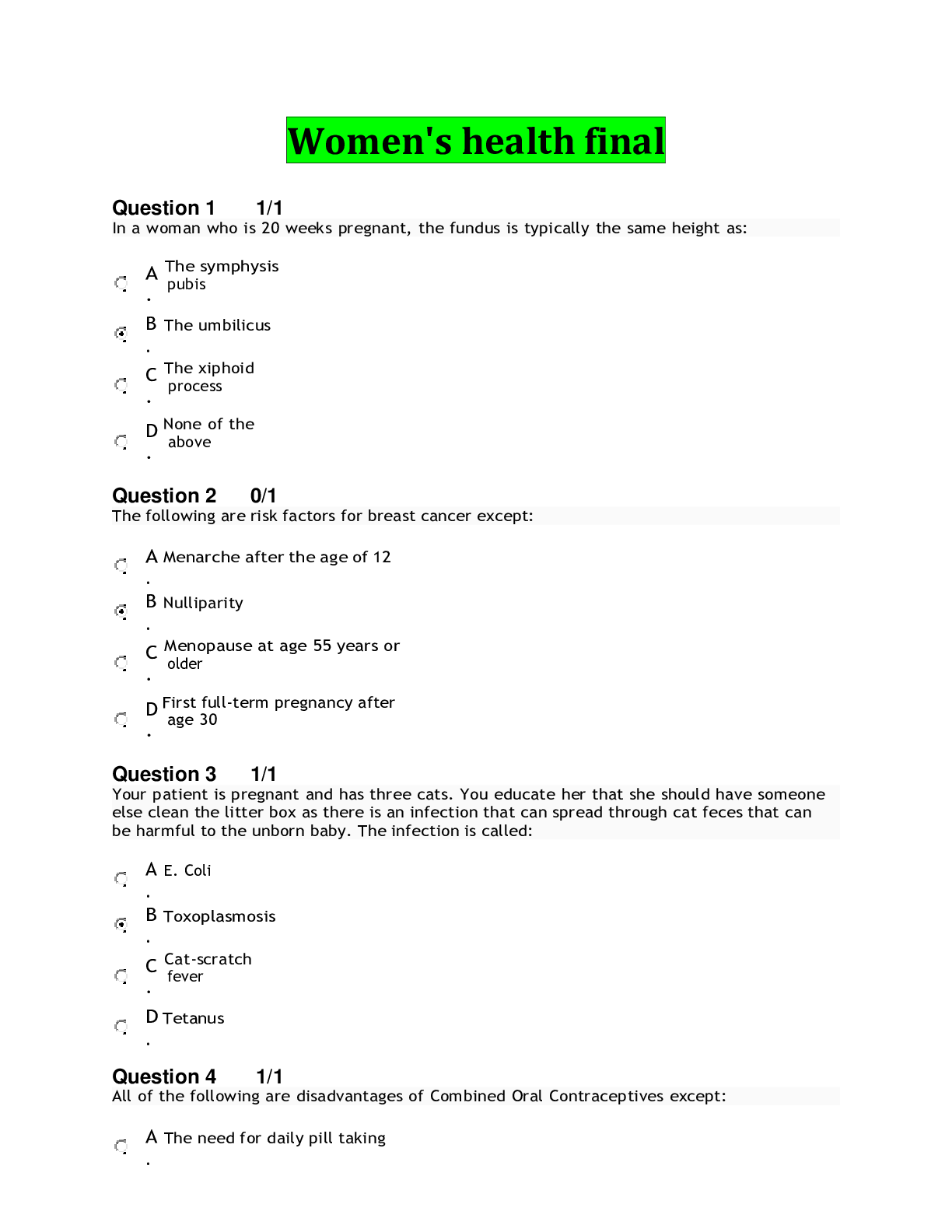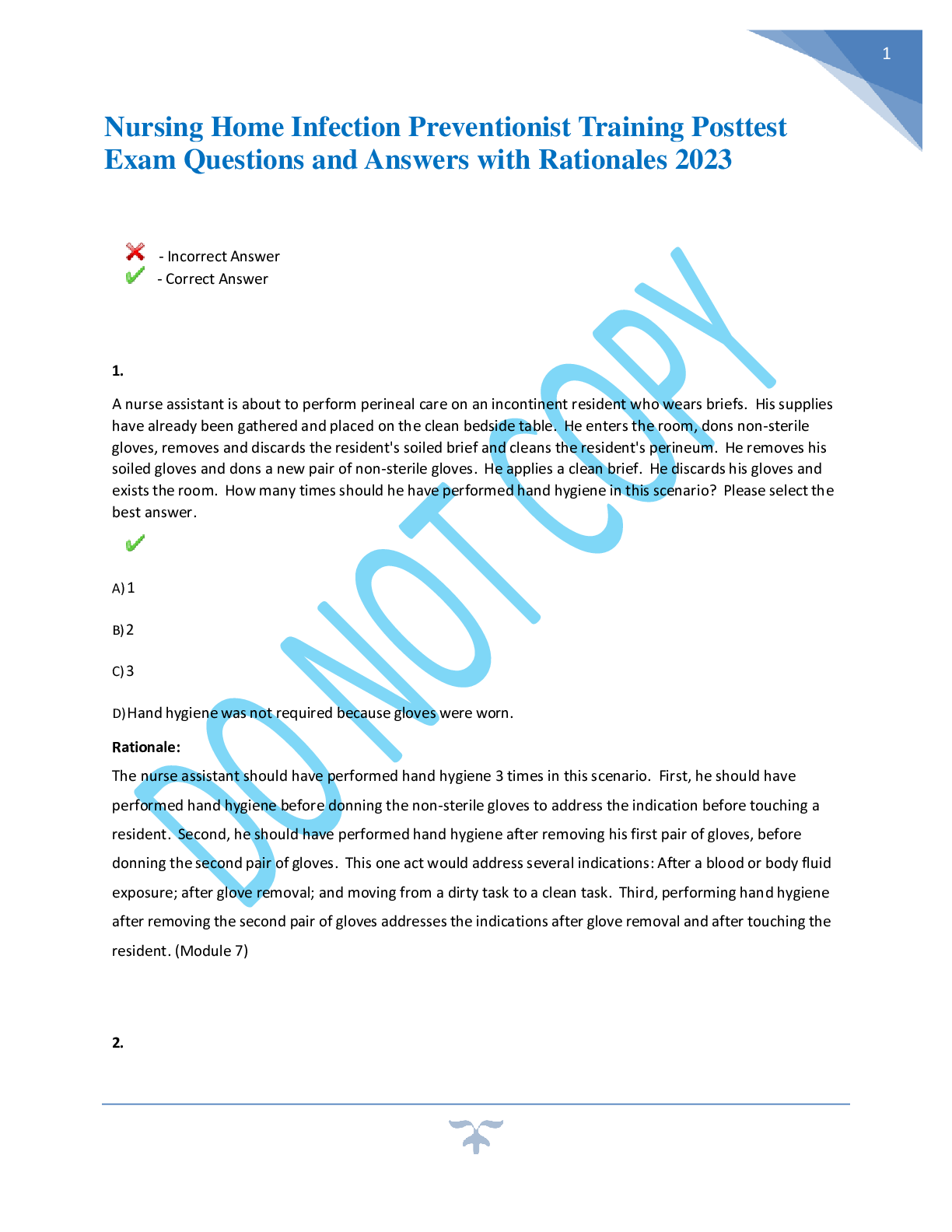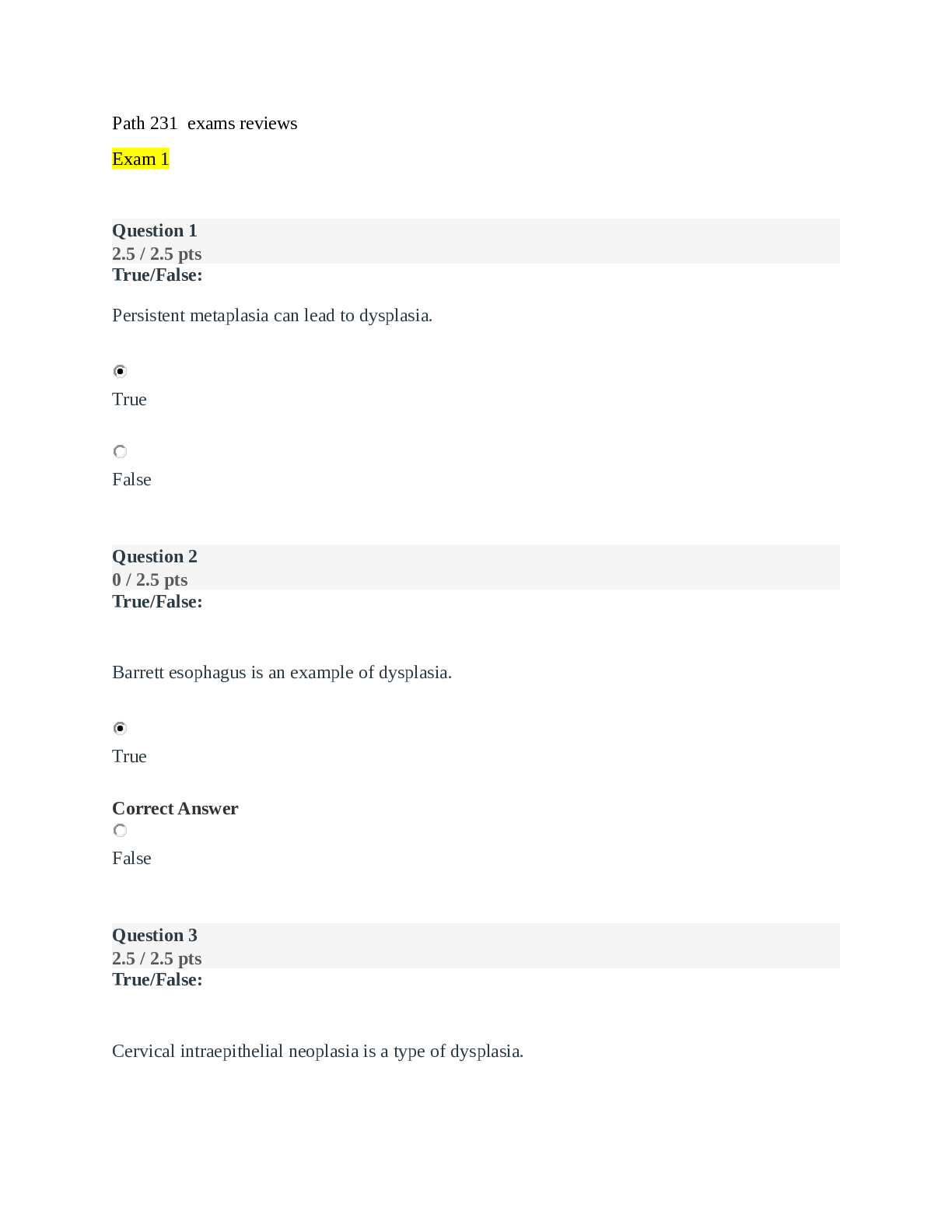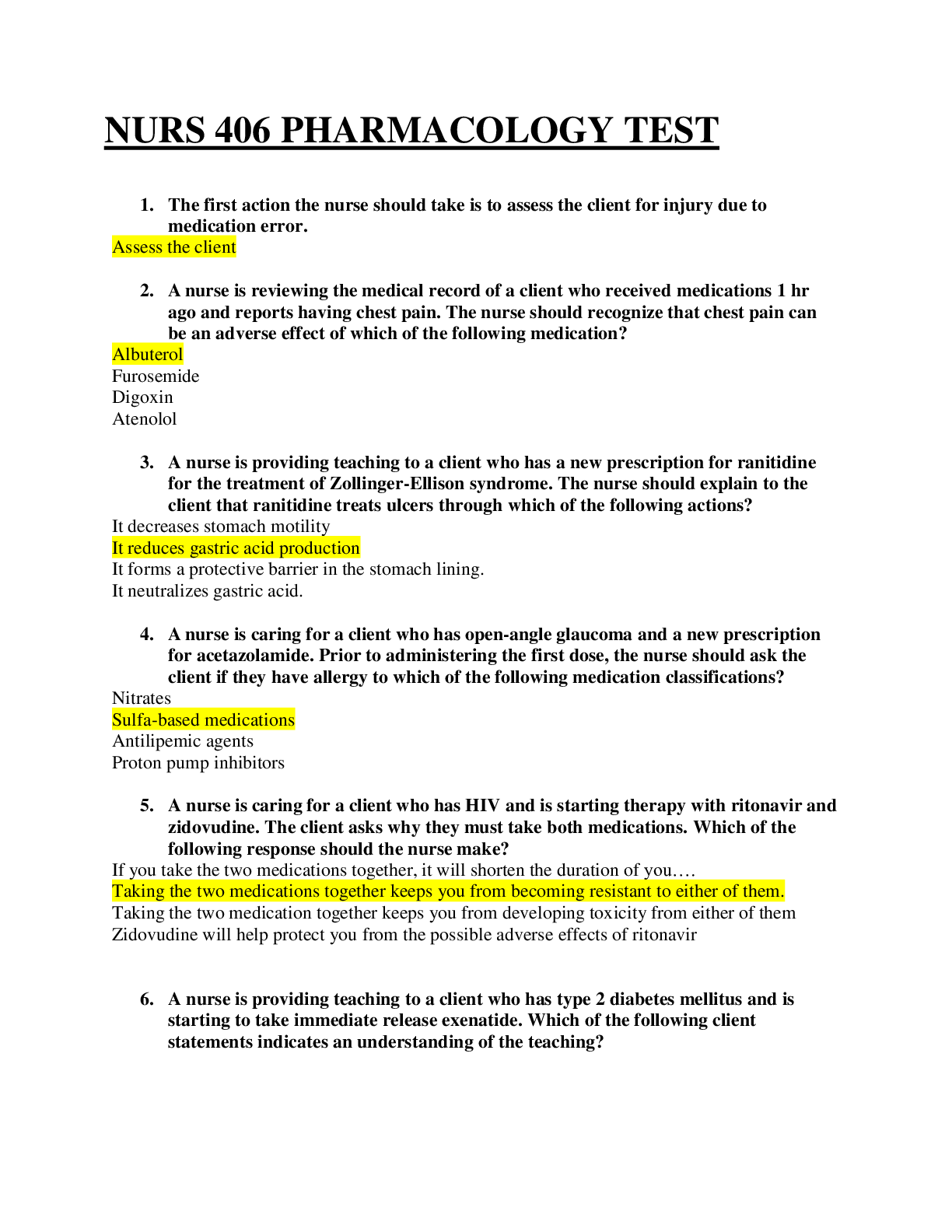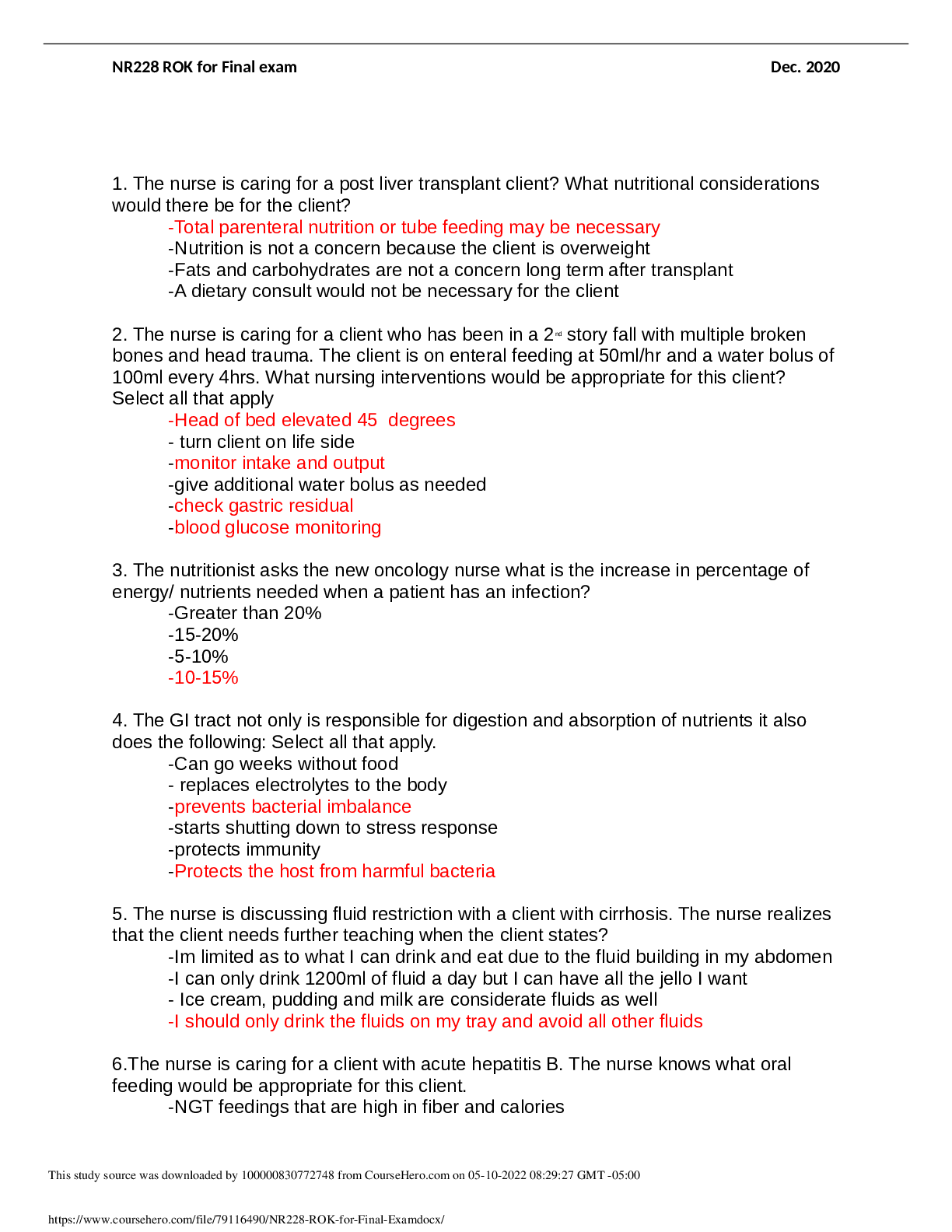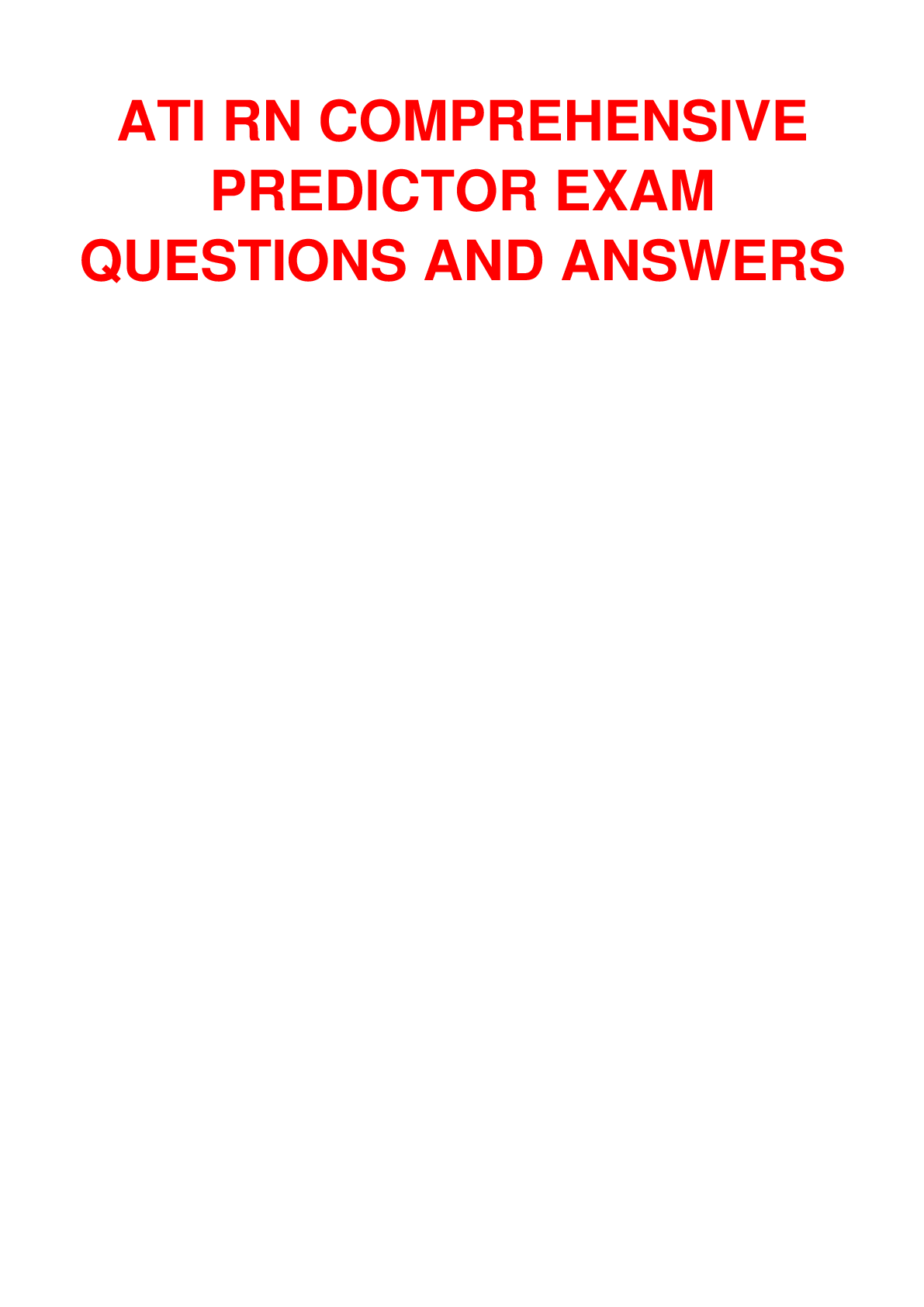Health Care > EXAM > RBT FINAL Exam QUESTIONS AND ANSWERS (All)
RBT FINAL Exam QUESTIONS AND ANSWERS
Document Content and Description Below
RBT FINAL Exam QUESTIONS AND ANSWERS Ethical Correct Answer: Pertaining to right and wrong in conduct. Being in accordance with the rules or standards for right conduct or practice Feedback and... Reflection Correct Answer: Respond appropriately to feedback and maintain or improve performance. Take feedback and be a reflective practitioner. Communication Correct Answer: Communication with stakeholders as authorized. Follow protocol of how to communicate. Communicate effectively with all team members. Professional Boundaries Correct Answer: Avoid dual relationships, conflicts of interest, social media contacts. Always take notes. Client Dignity Correct Answer: Be respectful and thoughtful about the client's needs and wants. Never do or say anything to cause embarrassment to the client. Do not do something in front of your client that you would not do if working with a typical developing child. How to Prepare for Data Collection Correct Answer: 1. Read data from last session 2. Prepare material and programs for current session based on data from last session. 3. Determine what programs you plan to work on during the session. 4. Gather materials for those programs. 5. Set up the first set of programs so they are ready for the client when you begin your session. The Role of the RBT in the Service Delivery System Correct Answer: Implement measurement, assessment, skill acquisition, behavior reduction, documentation and reporting, and maintain professional conduct in the scope of the practice under the direct supervision of a BCBA or BCaBA. RBT Assisting with Individual Assessment Procedures Correct Answer: The RBT can interview stakeholders, gather baseline data by observing the client's behaviors in his/her natural environment, or probe client by asking them to perform a task we are unsure they can perform without providing assistance. Dealing with Stakeholders Correct Answer: The RBT should only communicate with stakeholders as authorized by the supervisor. Any specific questions should be deferred to the BCBA or BCaBA. If you do communicate you must be objective, use behavioral language, avoid speculation, stick to topic appropriate for an RBT. Assist Training Stakeholders Correct Answer: RBT can assist with training stakeholders by giving them instruction, modeling, rehearsal, and feedback with regard to behavioral skills training. Report Other Variables Correct Answer: illness, relocation or change in medication. Components of a Written Behavior Plan Correct Answer: 1. Identify, describe, create a goal for a behavior in observable terms. 2. Assess antecedent/consequence that may maintain behavior. 3. Identify hypothesis of function of behavior. 4. Identify possible replacement behaviors. 5. Select and implement antecedent/consequence based interventions. 6. Create crisis intervention plan. 7. Implementation, modification, generalization and maintenance procedures. Skill Acquisition Plan Correct Answer: 7 Components 1. Identify the skill deficit 2. Create a goal to address the deficit 3. Establish a data measurement system 4. Take baseline data (Assess current skill level) 5. Select and implement an acquisition procedure. 6. Collect data to assess effectiveness of the procedure. 7. Modify existing plan based on assessment data. (Modify, if necessary) to maintain/increase effectiveness) Prepare for Skill Acquisition Plan Correct Answer: 1. Determine what occurred last session to decide where to start. 2. Select skill acquisition procedures to complete during session. 3. Prepare materials you will need for the skill acquisition (including data collection protocols). 5 Dimensions we can Shape Correct Answer: 1. Topography 2. Frequency 3. Latency 4. Duration 5. Amplitude/Intensity Applied Behavior Analysis Correct Answer: The science in which tactics derived from the principles of behavior are applied systematically to improve socially significant behavior and experimentation is used to identify the variables responsible for behavior change. The scientific study of principles of learning and behavior. Behavior Correct Answer: An activity of living organisms. What an individual does (how they respond in the situation). It is observable and measurable. Response Correct Answer: Specific instance of behavior. 4 types of Responses: 1. Correct 2. Incorrect 3. Non-Response 4. Prompted Respondent Behavior Correct Answer: Untaught or unconditioned responses. Reflex. Respondent Conditioning Correct Answer: New stimuli can acquire the ability to elicit responses. Occurs through pairing of two stimuli. Stimulus - Stimulus Pairing (S - S) Unconditioned Stimulus Correct Answer: A stimulus that elicits an unconditioned response. i.e. Food is an unconditioned stimulus for a hungry animal and salivation is the unconditioned response. Unconditioned Response Correct Answer: A behavior that occurs naturally due to a given stimulus. i.e. Dogs salivating in the presence of food; yelping upon being bitten by an insect. Conditioned Stimulus Correct Answer: A previously neutral stimulus that, after repeated association with an unconditioned stimulus, elicits the response produced by the unconditioned stimulus itself. Conditioned Response Correct Answer: A behavior that does not come naturally, but must be learned by the individual by pairing a neutral stimulus with an unconditioned stimulus. Unconditioned Reinforcers Correct Answer: (AKA primary reinforcers) Stimuli that do not require learning. (i.e. food, water, warmth, sleep, sexual stimulation) Conditioned Reinforcers Correct Answer: (AKA secondary reinforcers) Neutral stimuli that have been paired with unconditioned reinforcers, or other conditioned reinforcers and through repeated pairing become reinforcers themselves. (i.e. stickers, sound, people) Generalized Conditioned Reinforcers Correct Answer: Stimuli that have been paired with a variety of unconditioned and conditioned reinforcers. (i.e. praise, attention, money, tokens) Operant Behavior Correct Answer: Behavior that is controlled or influenced by consequences. Behavior whose future frequency is determined by a history of consequences. Operant Conditioning Correct Answer: A type of learning where behavior is controlled by consequences. Behavior followed by pleasant consequences tends to be repeated. Behavior followed by unpleasant consequences tends not to be repeated. Mand Training Correct Answer: (AKA request training) Training by asking for what you want. Reinforcers Correct Answer: Pleasant events that follow a behavior that make behavior more likely to occur in the future. Reinforcers strengthen behavior. Punishers Correct Answer: Unpleasant events that follow a behavior and decrease the likelihood that a behavior will happen again in the future. 4 - Part Contingency of Operant Learning Correct Answer: 1. MO - Motivating Operation 2. Antecedent 3. Behavior 4. Consequence Motivating Operation Correct Answer: (AKA setting event) Contextual factors or conditions that influence behavior. Influence how an individual is going to react. (i.e. Being deprived of food and water) Antecedent Correct Answer: What occurs before a behavior that then influences behavior. An environment or a stimulus change existing or occurring prior to a behavior of interest. Prompt Correct Answer: Specific antecedent that directly facilitates performance of behavior. Assistance provided to engage in desired behavior or response. Consequence Correct Answer: Events that follow behavior and may influence it including increasing or decreasing it in the future. May be reinforcers or punishers. 7 Dimensions of ABA Correct Answer: 1. Applied 2. Behavioral 3. Analytic 4. Technological 5. Conceptual Systems 6. Effective 7. Generality Frequency Data Correct Answer: (AKA Event Recording) A form of continuous measurement. Data in which you tally each time the behavior occurs. Typically used for behaviors with discrete beginning and ending points. Typically used for behaviors with discrete beginning and ending points. (i.e. throwing items, going to the gym, taking medicine, hitting another person) Most frequently used type of data collection. Duration Data Correct Answer: Data that is a calculation of the amount of time a behavior occurs. The amount of time a response is performed. Track from onset to offset. Typically used for behaviors that last too long or too short. (i.e. on task behavior, social interactions, engaging in stereotypy) Antecedent Behavior Consequence Data Correct Answer: (AKA ABC data) A combination of information about what happens before, during and after a behavior. A form of continuous measurement. Interval Recording Correct Answer: A form of discontinuous measurement. Used for estimating duration of a behavior in which observers periodically look at client at predetermined intervals and record whether or not a behavior is occurring. Partial Interval Recording Correct Answer: Did the behavior occur at least once during the short observation interval? Overestimates the behavior. Example: presence or absence of thumb-sucking within a series of time intervals. Whole Interval Recording Correct Answer: Did the behavior occur for the whole interval that you are [Show More]
Last updated: 1 year ago
Preview 1 out of 15 pages

Reviews( 0 )
Document information
Connected school, study & course
About the document
Uploaded On
Aug 12, 2022
Number of pages
15
Written in
Additional information
This document has been written for:
Uploaded
Aug 12, 2022
Downloads
0
Views
33


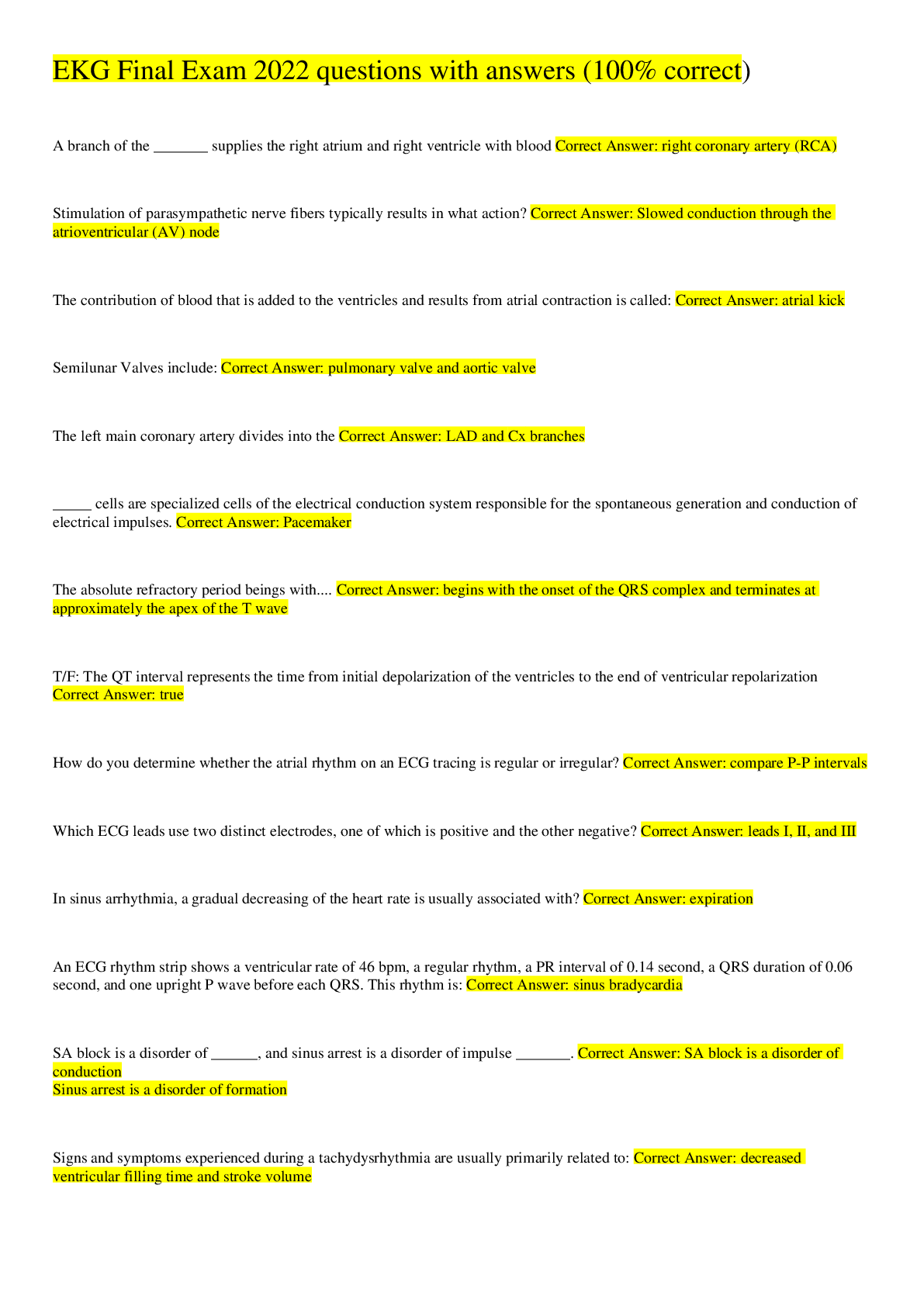
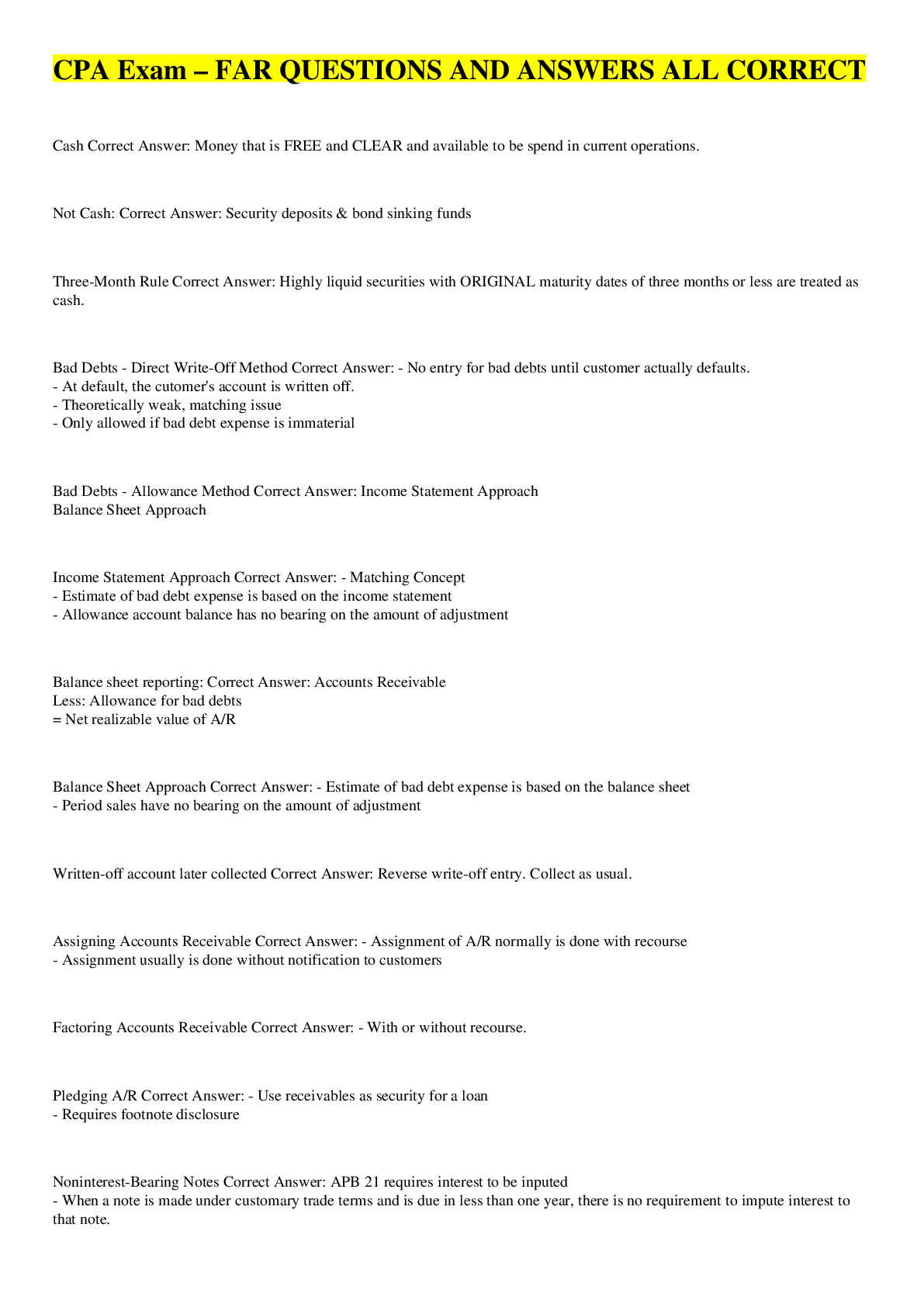
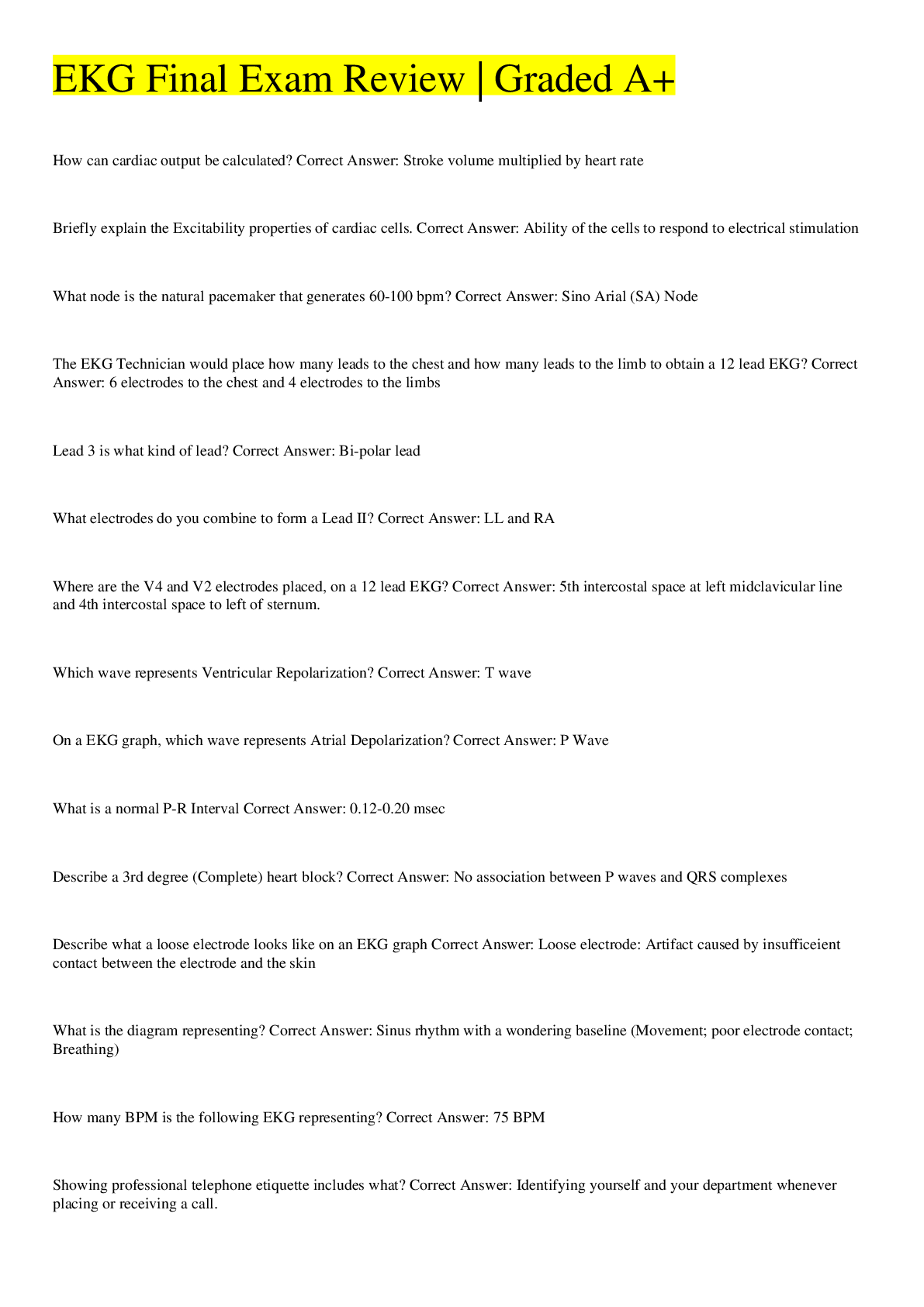
.png)

